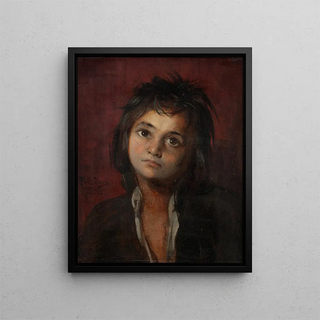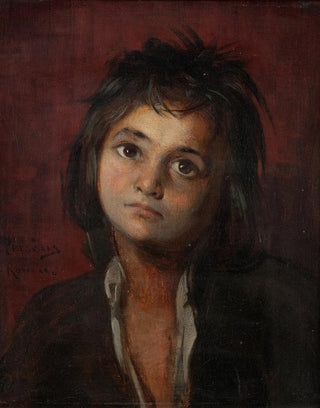Art print | Study of a Roman Boy - Edvard Persus


View from behind

Frame (optional)
Art print Étude d'un garçon romain - Edvard Persus – Introduction captivante
The artwork "Étude d'un garçon romain" by Edvard Persus evokes a bygone era, where art was not only a form of expression but also a means of capturing the essence of humanity. This painting, both delicate and powerful, transports us to the heart of ancient Rome, offering a fascinating glimpse into daily life at that time. The depiction of a young boy, frozen in a contemplative pose, invites us to reflect on the values, aspirations, and emotions of the individuals who shaped this civilization. Through this piece, Persus does not merely reproduce an image; he provides us with a window into a world rich in history and culture.
Style and uniqueness of the work
What sets "Étude d'un garçon romain" apart is Edvard Persus's technical mastery, which manages to combine realism and sensitivity. The meticulous details of the skin texture, the subtle nuances of light and shadow, as well as the boy's facial expression, demonstrate a deep commitment to artistic truth. Persus uses a palette of earthy colors, evoking the warmth of the Mediterranean climate and the simplicity of daily life. Every brushstroke seems charged with emotion, and the overall composition exudes an atmosphere of serenity and reflection. This art print is not just a study of the human figure but also an exploration of the soul, capturing a moment of introspection that resonates through the ages.
The artist and his influence
Edvard Persus, although less known than some of his contemporaries, has made a place for himself in the pantheon of influential artists of his time. His ability to fuse classical techniques with modern sensitivity has allowed his work to reach a broad audience. Persus draws inspiration from Renaissance masters, while infusing a freshness and originality that are uniquely his own. His work has paved the way for new interpretations of the human figure, encouraging other artists to explore similar themes. The impact of his art transcends the boundaries of his era, and his influence is still felt today, as contemporary artists strive to capture the complex

Matte finish

View from behind

Frame (optional)
Art print Étude d'un garçon romain - Edvard Persus – Introduction captivante
The artwork "Étude d'un garçon romain" by Edvard Persus evokes a bygone era, where art was not only a form of expression but also a means of capturing the essence of humanity. This painting, both delicate and powerful, transports us to the heart of ancient Rome, offering a fascinating glimpse into daily life at that time. The depiction of a young boy, frozen in a contemplative pose, invites us to reflect on the values, aspirations, and emotions of the individuals who shaped this civilization. Through this piece, Persus does not merely reproduce an image; he provides us with a window into a world rich in history and culture.
Style and uniqueness of the work
What sets "Étude d'un garçon romain" apart is Edvard Persus's technical mastery, which manages to combine realism and sensitivity. The meticulous details of the skin texture, the subtle nuances of light and shadow, as well as the boy's facial expression, demonstrate a deep commitment to artistic truth. Persus uses a palette of earthy colors, evoking the warmth of the Mediterranean climate and the simplicity of daily life. Every brushstroke seems charged with emotion, and the overall composition exudes an atmosphere of serenity and reflection. This art print is not just a study of the human figure but also an exploration of the soul, capturing a moment of introspection that resonates through the ages.
The artist and his influence
Edvard Persus, although less known than some of his contemporaries, has made a place for himself in the pantheon of influential artists of his time. His ability to fuse classical techniques with modern sensitivity has allowed his work to reach a broad audience. Persus draws inspiration from Renaissance masters, while infusing a freshness and originality that are uniquely his own. His work has paved the way for new interpretations of the human figure, encouraging other artists to explore similar themes. The impact of his art transcends the boundaries of his era, and his influence is still felt today, as contemporary artists strive to capture the complex






